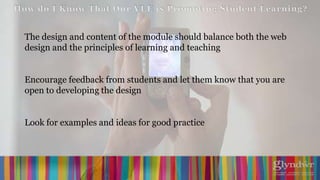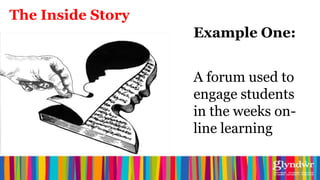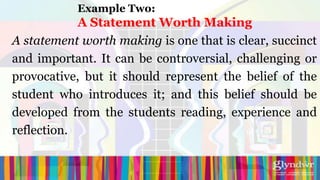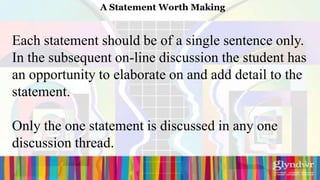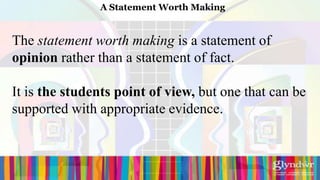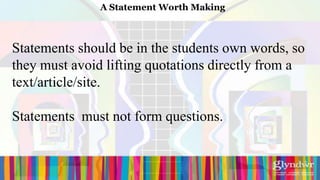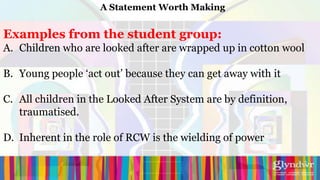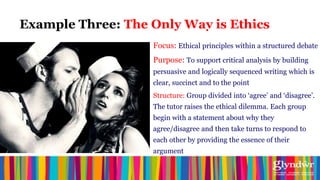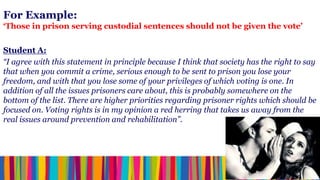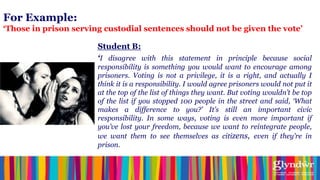A stich in virtual time
- 3. The design and content of the module should balance both the web design and the principles of learning and teaching Encourage feedback from students and let them know that you are open to developing the design Look for examples and ideas for good practice
- 4. Forums with threaded discussions can facilitate and encourage collaboration and communication.
- 5. Key Principles for the Module Tutor ŌĆó Starter questions need to be creative even controversial to prompt a response from the student group ŌĆó Tutor response to postings needs to be prompt, always value contributions and respond constructively ŌĆó Be strategic in your response (same principle as face to face teaching) ŌĆó Monitor participation and offer support ŌĆó Know when the forum discussion has run its course
- 6. The Inside Story Example One: A forum used to engage students in the weeks on- line learning
- 7. Example Two: A Statement Worth Making A statement worth making is one that is clear, succinct and important. It can be controversial, challenging or provocative, but it should represent the belief of the student who introduces it; and this belief should be developed from the students reading, experience and reflection.
- 8. A Statement Worth Making Each statement should be of a single sentence only. In the subsequent on-line discussion the student has an opportunity to elaborate on and add detail to the statement. Only the one statement is discussed in any one discussion thread.
- 9. A Statement Worth Making The statement worth making is a statement of opinion rather than a statement of fact. It is the students point of view, but one that can be supported with appropriate evidence.
- 10. A Statement Worth Making Statements should be in the students own words, so they must avoid lifting quotations directly from a text/article/site. Statements must not form questions.
- 11. A Statement Worth Making Examples from the student group: A. Children who are looked after are wrapped up in cotton wool B. Young people ŌĆśact outŌĆÖ because they can get away with it C. All children in the Looked After System are by definition, traumatised. D. Inherent in the role of RCW is the wielding of power
- 12. Example Three: The Only Way is Ethics The Only Way is Ethics Focus: Ethical principles within a structured debate Purpose: To support critical analysis by building persuasive and logically sequenced writing which is clear, succinct and to the point Structure: Group divided into ŌĆśagreeŌĆÖ and ŌĆśdisagreeŌĆÖ. The tutor raises the ethical dilemma. Each group begin with a statement about why they agree/disagree and then take turns to respond to each other by providing the essence of their argument
- 13. The Only Way is Ethics The Only Way is Ethics Example: ŌĆ×Those in prison serving a custodial sentence should not be given the voteŌƤ.
- 14. For Example: ŌĆśThose in prison serving custodial sentences should not be given the voteŌĆÖ Student A: ŌĆ£I agree with this statement in principle because I think that society has the right to say that when you commit a crime, serious enough to be sent to prison you lose your freedom, and with that you lose some of your privileges of which voting is one. In addition of all the issues prisoners care about, this is probably somewhere on the bottom of the list. There are higher priorities regarding prisoner rights which should be focused on. Voting rights is in my opinion a red herring that takes us away from the real issues around prevention and rehabilitationŌĆØ.
- 15. For Example: ŌĆśThose in prison serving custodial sentences should not be given the voteŌĆÖ Student B: ŌĆśI disagree with this statement in principle because social responsibility is something you would want to encourage among prisoners. Voting is not a privilege, it is a right, and actually I think it is a responsibility. I would agree prisoners would not put it at the top of the list of things they want. But voting wouldnŌƤt be top of the list if you stopped 100 people in the street and said, ŌĆ×What makes a difference to you?ŌƤ ItŌƤs still an important civic responsibility. In some ways, voting is even more important if youŌƤve lost your freedom, because we want to reintegrate people, we want them to see themselves as citizens, even if theyŌƤre in prison.
- 16. Any questions?
Editor's Notes
- #4: How do I make sure that our VLE is promoting student learning
- #7: Example of a forum used to engage students in the weeks on-line learning:Students are asked to:Read lecture two and look at the handout provided. The homework task is to post an example from your practice╠²this week at work where you have applied this theoretical concept. Locate this example on the grid provided and explain this decision. Each student begins a new thread.Students are encouraged to constructively comment on each others practice example.
- #8: This forum is an example of a structured discussion method. Students are asked to prepare a ŌĆśstatement worth makingŌĆÖ and to post their statement within the form called ŌĆśA statement worth making forumŌĆÖ. Precis instruction about how to do this are provided.
- #13: This forum developed on from the previous idea although this time the students work in two groups.


